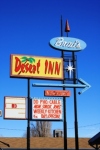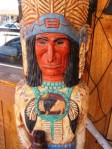More…. Cigar Store Indians ….
Category Archives: American Indian
The Hoop Dance
The Hoop Dance is a form of dance that a solo dancer performs to tell a story with anywhere from 1 to 30 hoops at a time…. each formation of hoops can represent an animal (ie… snake, eagle, coyote) that is integral to the storytelling. Also, each hoop represents the circle of life.
The various hoop formations occur around and about the dancer’s body. To create the various formations, the hoops are arranged to interconnect. While interconnected, the hoops are extended from the dancer’s body to create the “wings”, “tails”, etc of the animal they are creating…. all this is done while the dance is moving very rapidly.
These photos were taken outside of the Hopi House on the South Rim of the Grand Canyon.
Route 40/66 – Holbrook, Arizona
Holbrook, Arizona, is a city on Interstate 40. It is located in eastern Arizona within close proximity to a number of Indian reservations and serves as the gateway to Petrified Forest National Park.
Holbrook has been around since the late 1800s. Founded by the Atlantic and Pacific Railroad (they named the town after their chief engineer) Holbrook was known at that time for being ranch country. Frontiersmen would come to Holbrook to set up and run their ranches. And where there are ranches… there are cattle and cattle rustlers… and of course it’s share of famous shootouts. One shootout ocurred at the Blevins House between the local sheriff and some cattle rustlers… The Blevins House still stands.
I would venture a guess that Holbrook’s biggest and most well known claim to fame is that it is also on Old Route 66… the Mother Road. I stopped in Holbrook on my drive back West and took many photos of the old motel and restaurant signs and murals.
- The Plainsman
- Butterfield Steakhouse
- Holbrook Inn
- Brad’s Desert Inn
- Pow Wow Trading Post
- Butterfield Steakhouse
- Holbrook Inn
- Curios
- Pow Wow Trading Post
- Young’s Corral
- Young’s Corral
- Young’s Corral
- Young’s Corral
- El Rancho Motel
- Gas Mart
Route 40 – Exit 303
I have to say that I LOVE the goofy old roadside attractions / stops that America offers along it’s highways and byways!
One such area for satisfying my love of all things kooky… is of course Route 66.
Yes, you can get your kicks there… but on Highway 40 there is another place… Exit 303… Adamana.
Cigar Store Indians
Cigar Store Indians are a form of American Folk Art dating back to the 1800s. Because many people couldn’t read or in the cas of immigrants read English, it was common to use visual signs and/or carvings to bridge the language barrier. Cigar Store Indians (aka Wooden Indians) were in front of tobacconist shops to direct illiterate customers to the shop. Other businesses used trade signs too… a barber pole for a barber shop, a key for a locksmith, a pair of scissors for a tailor or three gold balls for a pawn shop. Said to be the most popular, the Indian was chosen for a tobacco shop because Indians introduced tobacco to early explorers of the Americas.
Cigar Store Indians are usually made of wood, are three dimensional and can be as large as life-sized. Due to a variety of reasons… sidewalk-obstruction laws, higher manufacturing costs, tobacco advertising restrictions and increased racial sensitivity… the Cigar Store Indian has become an advertising antiquity.
- Panguitch, Utah
- Panguitch, Utah
- Mt. Carmel, Utah
- Mt. Carmel, Utah
- Panguitch, Utah
- Oatman, AZ
- Oatman, AZ
- Oatman, AZ
- Oatman, AZ
- Oatman, AZ
Cabot’s Pueblo Museum (b/w)
Here are some photos I got creative with… in black & white.
- Saint Francis by Benjiamino Buffano.
- Motor fuel only.
- Looking through the window.
- Waokiye
- Saint Francis by Benjiamino Buffano




























































